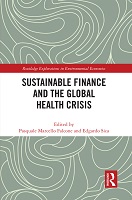Chapter 12 Social dimension of green finance
Covid-19 shines spotlight on companies’ vulnerable employment in supply chains
| dc.contributor.author | Hitaj, Claudia | |
| dc.contributor.author | Popescu, Ioana-Stefania | |
| dc.contributor.author | Schaubroeck, Thomas | |
| dc.contributor.author | Gibon, Thomas | |
| dc.date.accessioned | 2024-02-22T13:40:44Z | |
| dc.date.available | 2024-02-22T13:40:44Z | |
| dc.date.issued | 2024 | |
| dc.identifier.uri | https://library.oapen.org/handle/20.500.12657/87794 | |
| dc.description.abstract | The speed with which the various economies recover from the Covid-19 pandemic will significantly determine the economic pressure placed on the environment in the medium-to-long-term. Furthermore, the pandemic has highlighted the strong interrelations between natural and societal systems, with societal resilience depending on a resilient environmental support system. In this context, the book argues that the pandemic represents a wake-up call for financial systems to be better prepared for the climate crisis and social risk, and has provided a stimulus to scale down the reliance of the global economy on fossil fuels. The first part of the book provides a deep and creative discussion between leading international researchers and experts on the policy options and financial instruments which can help to catalyze the green finance transition in the post-Covid-19 era. The contributions show that sustainable finance is emerging as a powerful tool to advance the transition towards a more environmentally and socially sustainable economic model. Instruments such as sovereign green bonds, green securities, and other sustainability-related securities can play a significant role in the post-Covid-19 world to fund economic stimulus and to lead the way to new and more sustainable future. The second part of the book supports the debate by highlighting a number of selected case studies on financing transitions in different regional contexts including Africa, Asia, Europe, and Latin America. The book marks a significant contribution to the literature on environmental economics and finance, climate change, and sustainability transitions. | en_US |
| dc.language | English | en_US |
| dc.subject.classification | thema EDItEUR::K Economics, Finance, Business and Management::KC Economics | en_US |
| dc.subject.classification | thema EDItEUR::K Economics, Finance, Business and Management::KC Economics::KCV Economics of specific sectors::KCVG Environmental economics | en_US |
| dc.subject.other | social,sustainable,investment,life-cycle assessment,LCA,Covid-19,supply chain,corporate social responsibility,Vulnerable Employment,GHG Emission,High GHG Emission,Country Industry Level,Climate Transition,Life Cycle Inventories,Electric Vehicles,Life Cycle GHG Emission,Stacked Column Charts,Revenue Breakdown,Low GHG Emission,Supply Chain Impacts,Social Scores,Apparel Sector,Global Trade Analysis Project,Monetary Units,Financial Database,Supply Chain,SHDB,Mining Metals,Multi-regional Input Output Model,UN,Global Sustainable Investment Alliance,Food Manufacturing Sectors,ESG Rating | en_US |
| dc.title | Chapter 12 Social dimension of green finance | en_US |
| dc.title.alternative | Covid-19 shines spotlight on companies’ vulnerable employment in supply chains | en_US |
| dc.type | chapter | |
| oapen.identifier.doi | 10.4324/9781003284703-14 | en_US |
| oapen.relation.isPublishedBy | 7b3c7b10-5b1e-40b3-860e-c6dd5197f0bb | en_US |
| oapen.relation.isPartOfBook | 1dda81de-1717-4ca3-9859-799530324424 | en_US |
| oapen.relation.isFundedBy | cffa151f-a606-4894-955b-9fa9afffb984 | en_US |
| oapen.relation.isbn | 9781032257228 | en_US |
| oapen.relation.isbn | 9781032257235 | en_US |
| oapen.imprint | Routledge | en_US |
| oapen.pages | 40 | en_US |

